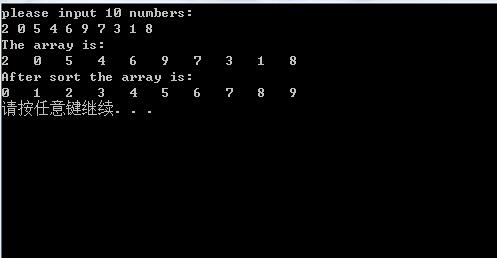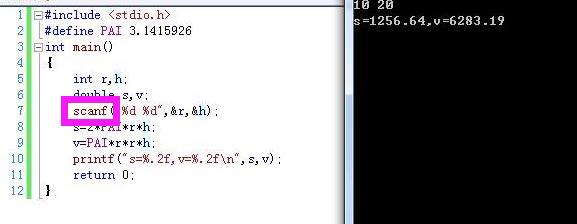C语言问题:从键盘输入十个整数,用选择排序法对输入的数据从小到大的顺序进行排序,将排序后的结果输出
Posted
tags:
篇首语:本文由小常识网(cha138.com)小编为大家整理,主要介绍了C语言问题:从键盘输入十个整数,用选择排序法对输入的数据从小到大的顺序进行排序,将排序后的结果输出相关的知识,希望对你有一定的参考价值。
#include <stdio.h>
#include <stdlib.h>
/* run this program using the console pauser or add your own getch, system("pause") or input loop */
int main(int argc, char *argv[])
int a[10],t,i,j;
for(i=0;i<=9;i++)
scanf("%d\n",&a[i]);
for(i=0;i<=9;i++)
for(j=i+1;j<=9;j++)
if(a[i]>a[j])
t=a[i];a[i]=a[j];a[j]=t;
for(i=0;i<=9;i++)
printf("%d",a[i]);
return 0;
这个程序执行的时候输入的是11个数,求解答
#include<stdio.h>
void SelectSort(int a[],int n)
int i,j,temp,min;
for(i=0;i<n-1;i++)
min=i;
for(j=i+1;j<n;j++)//找到最小元素的位置
while(a[j]<a[min])
min=j;
if(min!=i)
temp=a[min];//元素的交换
a[min]=a[i];
a[i]=temp;
void main()
int a[10],i;
printf("please input 10 numbers:\\n");
for(i=0;i<10;i++)
scanf("%d",&a[i]);
printf("The array is:\\n");
for(i=0;i<10;i++)
printf("%-4d",a[i]);
SelectSort(a,10);
printf("\\nAfter sort the array is:\\n");
for(i=0;i<10;i++)
printf("%-4d",a[i]);
printf("\\n");
运行效果:

扩展资料:
scanf函数用法:
scanf("输入控制符",输入参数);
功能:将从键盘输入的字符转化为“输入控制符”所规定格式的数据,然后存入以输入参数的值为地址的变量中。
用scanf()函数以%s格式读入的数据不能含有空白符时,所有空白符都被当做数据结束的标志。所以题中函数输出的值只有空格前面的部分。
如果想要输出包括空格在内的所有数据,可以使用gets()函数读入数据。gets()函数的功能是读取字符串,并存放在指定的字符数组中,遇到换行符或文件结束标志时结束读入。换行符不作为读取串的内容,读取的换行符被转换为字符串结束标志'\\0'。
参考技术A 问题是在scanf("%d\n",&a[i]);,其实还是识别10个输入数。问题关键是输入格式,\n,输入完10个数必须要有一个\n,但是单独的\n是不能识别的,所以需要至少加一个字符,引出\n,也就是你误以为的第十一个数。
修改意见:scanf("%d\n",&a[i]);改为scanf("%d",&a[i]);本回答被提问者采纳 参考技术B //该带的括号都带好 注意编码规范
#include <stdio.h>
#include <stdlib.h>
/* run this program using the console pauser or add your own getch, system("pause") or input loop */
int main(int argc, char *argv[])
int a[10],t,i,j;
for(i=0;i<=9;i++)
scanf("%d",&a[i]); // \\n去掉
for(i=0;i<=9;i++)
for(j=i+1;j<=9;j++)
if(a[i]>a[j])
t=a[i];
a[i]=a[j];
a[j]=t;
for(i=0;i<=9;i++)
printf("%d ",a[i]);
return 0;
23 45 67 43 87 88 86
43 87 69
23 43 43 45 67 69 86 87 87 88 Press any key to continue 参考技术C scanf("%d\n",&a[i]);你这里输入格式不要加‘\n’,直接写scanf("%d",&a[i]); 参考技术D #include <stdio.h>
#include <stdlib.h>
#define N 10
/* run this program using the console pauser or add your
own getch, system("pause") or input loop */
int main(int argc, char *argv[])
int a[N],t,i,j;
for(i=0;i<N;i++)
scanf("%d",&a[i]);
for(i=0;i<N;i++)
for(j=i+1;j<N;j++)
if(a[i]>a[j])
t=a[i];a[i]=a[j];a[j]=t;
for(i=0;i<N;i++)
printf("%d",a[i]);
return 0;
C语言作业: 从键盘输入3个整数,按照从小到大的顺序输出
#include<stdio.h>
void main()
int a,b,c,t;
printf("请输入三个整数:a b c\\n");
scanf("%d%d%d",&a,&b,&c);
if(a>b)
t=a;
a=b;
b=t;
if(a>c)
t=a;
a=c;
c=t;
if(b>c)
t=b;
b=c;
c=t;
printf("排序后的三个整数为:%d,%d,%d\\n",a,b,c);

扩展资料:
scanf函数原型
int(const char*restrict format,...);
函数scanf()是从标准输入流stdin(标准输入设备,一般指向键盘)中读内容的通用子程序,可以说明的格式读入多个字符,并保存在对应地址的变量中。
函数的第一个参数是格式字符串,它指定了输入的格式,并按照格式说明符解析输入对应位置的信息并存储于可变参数列表中对应的指针所指位置。每一个指针要求非空,并且与字符串中的格式符一一顺次对应。
返回值
scanf函数返回成功读入的数据项数,读入数据时遇到了“文件结束”则返回EOF。
如:
scanf("%d%d",&a,&b);
函数返回值为int型。如果a和b都被成功读入,那么scanf的返回值就是2;
如果只有a被成功读入,返回值为1;
如果a和b都未被成功读入,返回值为0;
如果遇到错误或遇到end of file,返回值为EOF。end of file为Ctrl+z或者Ctrl+d。
例:使用scanf函数输入数据。
#include<stdio.h>
int main(void)
int a,b,c;
printf("Give me the value of a,b,c seperated with whitespaces:\\n");
scanf("%d%d%d",&a,&b,&c);
printf("a=%d,b=%d,c=%d\\n",a,b,c);
return 0;
&a,&b,&c中的&是寻址操作符,&a表示对象a在内存中的地址,是一个右值。变量a,b,c的地址是在编译阶段分配的(存储顺序由编译器决定)。
注意:如果scanf中%d是连着写的如“%d%d%d”,在输入数据时,数据之间不可以用逗号分隔,只能用空白字符(空格或tab键或者回车键)分隔——
“2(空格)3(tab)4”或“2(tab)3(回车)4”等。若是“%d,%d,%d”,则在输入数据时需要加“,”,如“2,3,4”。
参考资料:
百度百科——scanf(计算机语言函数)
void main()
int a,b,c,t;
printf("请输入三个整数:a b c\\n");
scanf("%d%d%d",&a,&b,&c);
if(a>b)
t=a;
a=b;
b=t;
if(a>c)
t=a;
a=c;
c=t;
if(b>c)
t=b;
b=c;
c=t;
printf("排序后的三个整数为:%d,%d,%d\\n",a,b,c);
以上是关于C语言问题:从键盘输入十个整数,用选择排序法对输入的数据从小到大的顺序进行排序,将排序后的结果输出的主要内容,如果未能解决你的问题,请参考以下文章